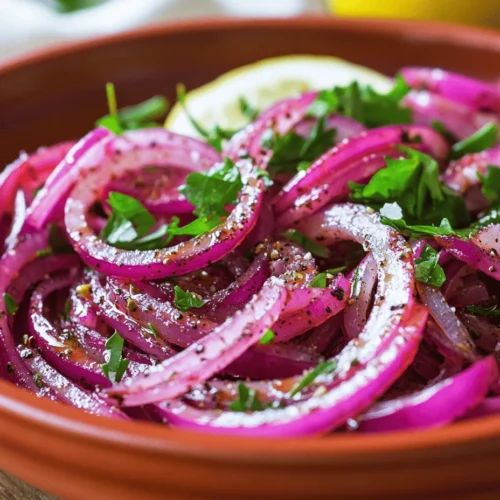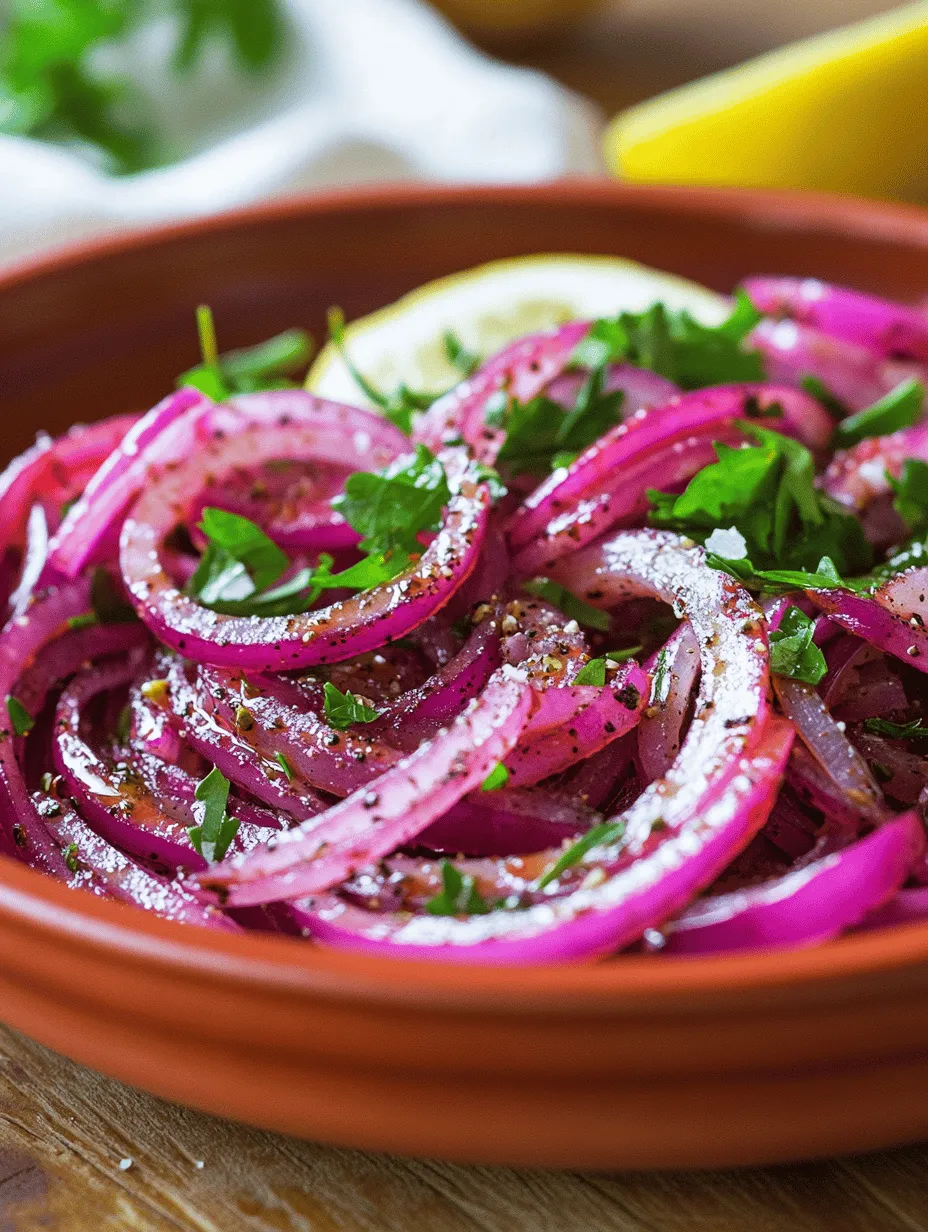In the world of culinary delights, the Zesty Sumac Onions stand out as a versatile and vibrant addition to any meal. This simple yet flavorful recipe not only enhances dishes with its zesty kick but also showcases the unique flavor profile of sumac, a spice often underutilized in Western cuisine. In this article, we will delve into the origins of sumac, the health benefits of onions, and how to perfectly prepare and serve these zesty onions to elevate your dining experience.
Understanding Sumac and Its Culinary Significance
Exploring the Origins of Sumac
Sumac, derived from the berries of the sumac bush (Rhus spp.), has a long history that dates back to ancient civilizations. This spice is particularly prevalent in Mediterranean and Middle Eastern cuisines, where it has been used for centuries to impart a tangy flavor to a variety of dishes. Sumac’s vibrant red color is visually appealing, making it an attractive addition to salads and grilled meats alike. The berries are harvested, dried, and ground into a coarse powder, which captures their tartness and aromatic qualities.
In traditional Middle Eastern cooking, sumac is often sprinkled over dishes like kebabs, rice, and salads, providing a refreshing contrast to rich flavors. Its unique taste can be described as somewhere between lemon and vinegar, offering a delightful acidity that can brighten any meal. As culinary trends shift towards a greater appreciation for global flavors, sumac is gaining recognition among chefs and home cooks alike, making it a worthy addition to your spice cabinet.
Understanding Its Flavor Profile
The flavor profile of sumac is one of its most distinctive characteristics. This spice offers a tart, citrusy flavor that can enhance the overall taste of a dish without overwhelming it. Unlike other acidic ingredients, sumac provides a subtle warmth and complexity that can elevate both savory and sweet dishes. Whether used as a seasoning, a garnish, or a key ingredient, sumac brings a unique punch that tantalizes the taste buds.
In the context of the Zesty Sumac Onions, the tartness of sumac beautifully complements the natural sweetness of the onions. This harmony of flavors creates a well-balanced taste experience, making these onions an ideal accompaniment to grilled meats, roasted vegetables, or even as a topping for sandwiches and salads.
Traditional Uses in Middle Eastern Cuisine
In Middle Eastern cuisine, sumac is revered not only for its flavor but also for its versatility. It is commonly featured in spice blends like za’atar, which pairs excellently with olive oil and bread. Additionally, sumac is often used to season meats, fish, and vegetables, enhancing their flavor profiles and offering a refreshing contrast to more robust ingredients.
Zesty Sumac Onions, in particular, are frequently used as a condiment in various dishes. The tartness cuts through the richness of meats, while the sweetness of the onions adds depth and complexity. These onions can be found alongside classic dishes such as shawarma, falafel, and various mezze platters, where they provide a burst of flavor and color.
How Sumac Enhances Dishes and Balances Flavors
The inclusion of sumac in dishes serves as a natural flavor enhancer, elevating the overall taste experience. Its acidity can brighten flavors, making it an excellent choice for balancing richer ingredients. In the case of Zesty Sumac Onions, the combination of the spice and the onions brings a refreshing contrast that can elevate any meal.
Moreover, sumac’s unique flavor profile allows it to pair well with a variety of ingredients, from grilled meats to robust grains. The zesty onions can be used to garnish hummus, accompany roasted vegetables, or even serve as a topping for tacos, showcasing their adaptability in the kitchen. The versatility of Zesty Sumac Onions makes them an essential element for those looking to explore new culinary horizons.
The Nutritional Benefits of Onions
Overview of Red Onions and Their Health Benefits
Onions, particularly red onions, are not only flavorful but also packed with nutritional benefits. Red onions are known for their vibrant color and slightly milder taste compared to yellow or white onions, making them a popular choice in salads and salsas. They are rich in antioxidants, vitamins, and minerals, contributing to a well-rounded diet.
One of the key health benefits of red onions is their high content of antioxidants, particularly quercetin. This powerful compound is known for its anti-inflammatory properties and has been linked to a reduced risk of chronic diseases, including heart disease and certain cancers. Incorporating red onions into your meals can boost your overall health while adding a delicious crunch and flavor.
Rich in Antioxidants and Vitamins
Red onions are a great source of vitamins C and B6, as well as essential minerals like potassium and manganese. Vitamin C plays a crucial role in immune function, skin health, and collagen production, while vitamin B6 is essential for brain health and metabolism. The potassium found in onions helps regulate blood pressure and supports heart health, making them a valuable addition to any diet.
Antioxidants, including quercetin and anthocyanins, not only provide health benefits but also contribute to the vibrant color of red onions. These compounds help combat oxidative stress in the body, reducing the risk of chronic diseases and promoting overall well-being.
The Role of Onions in a Balanced Diet
Incorporating onions into your diet can enhance flavor without adding excessive calories or unhealthy ingredients. They are low in calories and high in fiber, making them an excellent choice for those looking to maintain a healthy weight. Fiber is essential for digestive health, promoting satiety and helping to regulate blood sugar levels.
Onions also add depth and flavor to dishes, reducing the need for added fats or sugars, which can contribute to healthier eating habits. By using Zesty Sumac Onions as a condiment or garnish, you can enhance the taste of your meals while reaping the numerous health benefits that onions have to offer.
How Onions Contribute to Heart Health and Anti-Inflammatory Properties
Research has shown that regular consumption of onions may contribute to heart health by helping to lower blood pressure and cholesterol levels. The anti-inflammatory properties of quercetin can also support cardiovascular health by reducing inflammation in the body. Additionally, onions have been linked to improved blood circulation, which is essential for maintaining overall health.
The combination of onions and sumac in Zesty Sumac Onions not only offers a delightful flavor profile but also promotes a heart-healthy diet. By incorporating these zesty onions into your meals, you can enjoy both their delicious taste and their numerous health benefits.
Ingredients Breakdown for Zesty Sumac Onions
To prepare Zesty Sumac Onions, you will need a few simple yet flavorful ingredients. The quality of these ingredients plays a crucial role in the overall flavor of the dish, so it’s important to select the best possible options.
Detailed List of Ingredients
1. Red Onions – 2 large, thinly sliced
2. Sumac – 2 tablespoons
3. Olive Oil – 2 tablespoons
4. Fresh Lemon Juice – 1 tablespoon
5. Salt – to taste
6. Black Pepper – to taste
7. Fresh Parsley (optional) – for garnish
The Importance of Quality Ingredients in Flavor
When preparing Zesty Sumac Onions, using high-quality ingredients is paramount. Fresh red onions will lend a natural sweetness and crispness to the dish. Look for onions that are firm and free of blemishes for the best flavor.
Sumac, being the star ingredient, should be sourced from a reputable supplier to ensure its freshness and potency. Fresh lemon juice adds brightness and acidity, enhancing the overall flavor of the onions. Extra virgin olive oil is recommended for its rich flavor and health benefits, contributing to a more vibrant dish.
The Role of Each Ingredient in the Recipe
– Red Onions: The primary ingredient in the recipe, red onions provide a sweet and slightly sharp flavor that complements the tanginess of sumac.
– Sumac: This spice adds a unique tartness, elevating the overall taste of the onions and balancing their sweetness.
– Olive Oil: Used to coat the onions, olive oil adds richness and helps to soften their texture, making them more palatable.
– Fresh Lemon Juice: The acidity from the lemon juice further enhances the tangy flavor of the sumac and helps to brighten the dish.
– Salt and Black Pepper: These seasonings are essential for bringing out the natural flavors of the ingredients and balancing the overall taste.
– Fresh Parsley: While optional, fresh parsley adds a pop of color and a fresh herbal note that can enhance the visual presentation and flavor of the dish.
By understanding the significance of each ingredient, you can confidently prepare Zesty Sumac Onions that not only taste fantastic but also showcase the unique qualities of sumac and onions. In the subsequent sections, we will explore the step-by-step instructions for making this delightful dish.

Substitutions and Variations for Dietary Preferences
When it comes to the Zesty Sumac Onions, the versatility of the recipe allows for various substitutions and variations to cater to different dietary preferences. Here are some suggestions:
– Onions: While red onions are the traditional choice, you can experiment with yellow onions or even shallots for a milder flavor. If you’re sensitive to onions, consider using thinly sliced cucumbers or radishes to achieve a similar crunch with a different taste profile.
– Sumac: If sumac is hard to find, you can create a substitute by mixing lemon zest with a touch of salt. However, this will not replicate the exact tanginess of sumac, so use sparingly and adjust to your taste.
– Olive Oil: For a lighter option, you can use avocado oil or grapeseed oil. Both provide a neutral flavor and are excellent for those following a higher-fat diet like keto or paleo.
– Vinegar: If you prefer a different acidity, try apple cider vinegar for a sweeter note, or balsamic vinegar for a richer flavor. These will change the overall taste but can create interesting variations.
– Herbs: Fresh herbs like parsley, cilantro, or mint can replace the dried herbs for a fresher taste. If you are looking for a more robust flavor, consider adding a pinch of cayenne pepper or red chili flakes.
By adapting the ingredients, you can create a version of Zesty Sumac Onions that suits your dietary needs without losing the essence of the dish.
Step-by-Step Guide to Preparing Zesty Sumac Onions
Preparation of Onions: Tips for Slicing and Handling
To achieve the best results in your Zesty Sumac Onions, proper preparation of the onions is crucial. Here’s how to do it:
1. Choosing the Right Onion: Opt for firm, unblemished red onions. The skin should be papery and dry. Avoid any onions with soft spots or sprouting.
2. Slicing: Begin by cutting off both ends of the onion. Peel away the outer skin, then cut the onion in half from top to bottom. Place the flat side down on the cutting board for stability. Slice thinly from root to tip, aiming for even thickness—around 1/8 inch is ideal. This ensures uniform marination and cooking.
3. Handling: If you’re sensitive to onion fumes, you can chill the onions in the refrigerator before slicing or soak them in cold water for a few minutes afterward. This helps reduce the pungency and makes them milder.
Combining Ingredients: Ensuring Even Coating and Seasoning
Once your onions are sliced, it’s time to combine them with the other ingredients. Follow these steps:
1. In a Mixing Bowl: Place the sliced onions into a large mixing bowl. Add the sumac, olive oil, vinegar, salt, and pepper.
2. Tossing: Use your hands or a large spoon to gently toss the ingredients together. Ensure that the onions are evenly coated with the oil and seasonings. This step is essential for flavor distribution.
3. Texture Considerations: If you prefer a softer texture, consider massaging the onions with your hands for a minute or two to help them release their juices. This not only flavors the onions but also softens them slightly.
Marinating Process: Why It Matters for Flavor Development
Marinating the onions is vital for enhancing their flavor. Here’s why and how to do it:
1. Timing: Allow the combined ingredients to marinate for at least 30 minutes at room temperature or up to several hours in the refrigerator. The longer the marination, the more intense the flavors will become.
2. Flavor Development: The acidity from the vinegar interacts with the onions, mellowing their sharpness while the sumac infuses its tangy flavor. This fusion creates a balanced taste profile that enhances your dishes.
3. Storage: If you have leftovers, store them in an airtight container in the refrigerator. They can last for up to a week, and the flavors will continue to develop over time.
Adjusting Flavors: How to Taste and Modify for Personal Preference
As you prepare your Zesty Sumac Onions, tasting and adjusting flavors is key. Here’s how to ensure they meet your personal preferences:
1. Balance of Flavors: After marinating, taste the onions. If they are too acidic, add a touch more olive oil or a pinch of sugar to balance the taste. If they lack tang, a bit more sumac or vinegar can help enhance the flavor.
2. Salt and Pepper: Adjust the seasoning to your liking. Salt can help bring out the natural sweetness of the onions, while pepper adds a subtle kick. Always add these in small increments and taste as you go.
3. Herb Adjustments: If you added fresh herbs, taste for their impact. Sometimes, a bit more freshness from herbs can elevate the dish even further.
Serving Suggestions for Zesty Sumac Onions
Zesty Sumac Onions bring versatility to your table, complementing a variety of dishes. Here are some serving suggestions:
Versatile Uses in Various Dishes
Zesty Sumac Onions can be utilized in numerous ways, making them a staple in your kitchen. Here are a few ideas:
– Salads: Toss them into green salads for added flavor and crunch. They pair wonderfully with leafy greens, tomatoes, and avocados.
– Tacos: Use them as a topping for tacos, enhancing the overall flavor profile with a refreshing twist.
– Rice Dishes: Mix them into grain bowls or alongside couscous for an aromatic side.
Pairing with Grilled Meats: Enhancing Flavors
One of the best ways to enjoy Zesty Sumac Onions is by pairing them with grilled meats. Here’s how they enhance those dishes:
– Grilled Chicken: The tartness of the onions cuts through the richness of grilled chicken, providing a refreshing balance.
– Lamb or Beef Kebabs: These onions can serve as a tangy topping for skewers, enhancing the savory flavors of the grilled meat.
– Fish Dishes: The bright flavors of the onions complement grilled or baked fish, particularly those with Mediterranean spices.
Incorporating into Pita Sandwiches: A Refreshing Addition
Zesty Sumac Onions make an excellent addition to pita sandwiches. Here’s how to incorporate them:
1. Filling Options: Fill your pita with grilled vegetables, falafel, or shawarma. Add a generous scoop of marinated onions for an extra burst of flavor.
2. Sauces and Spreads: Pair with tahini sauce, yogurt, or hummus to create a balanced and filling meal that satisfies.
As Part of a Mezze Platter: Creating a Vibrant Spread
Zesty Sumac Onions are a fantastic component of a mezze platter. Here’s how to arrange a vibrant spread:
1. Include Variety: Combine these onions with other mezze staples like baba ganoush, tzatziki, olives, and stuffed grape leaves.
2. Presentation: Use colorful bowls and garnishes to create an appealing visual display. The bright pink of the onions will stand out against the greens and earthy tones of the other dishes.
The Role of Garnishes in Culinary Presentation
Presentation plays a significant role in cooking and can elevate an ordinary dish to an extraordinary one. Here’s how garnishes enhance Zesty Sumac Onions:
Importance of Presentation in Food
– Visual Appeal: A well-presented dish is more enticing and can enhance the overall dining experience. Colors, textures, and arrangement contribute to the first impression.
– Culinary Experience: When food is visually appealing, it sets the stage for a delightful dining experience. Garnishes can make the dish look sophisticated and more appetizing.
How Garnishes Elevate the Dish Visually and Flavor-wise
– Flavor Complementation: Garnishes can add a layer of flavor that enhances the main dish. Fresh herbs, for example, not only add color but also a burst of freshness.
– Texture Variety: A crunchy garnish can contrast beautifully with the softness of marinated onions, creating a more enjoyable mouthfeel.
Suggestions for Additional Garnishes that Complement the Zesty Onions
Consider these garnishes to enhance your Zesty Sumac Onions:
– Fresh Herbs: Sprinkle chopped parsley, mint, or cilantro on top just before serving. These herbs will add freshness and color.
– Pomegranate Seeds: The jewel-like seeds add a pop of color and a sweet-tart flavor that works wonderfully with the zingy onions.
– Toasted Nuts or Seeds: A sprinkle of toasted pine nuts or sesame seeds can provide a delightful crunch and enhance the dish’s richness.
Conclusion
Zesty Sumac Onions are more than just a side dish; they are a celebration of flavor and health that can transform your meals. With their vibrant taste and numerous health benefits, these onions are a must-try for anyone looking to add a touch of zest to their table. By understanding the ingredients and methods behind this recipe, you can confidently create a dish that not only tantalizes the taste buds but also provides nutritional value.
Whether you choose to serve them alongside grilled meats, incorporate them into pita sandwiches, or include them on a mezze platter, these onions will elevate your culinary creations. So gather your ingredients, follow the steps, and enjoy the burst of flavor that Zesty Sumac Onions bring to your dining experience.



